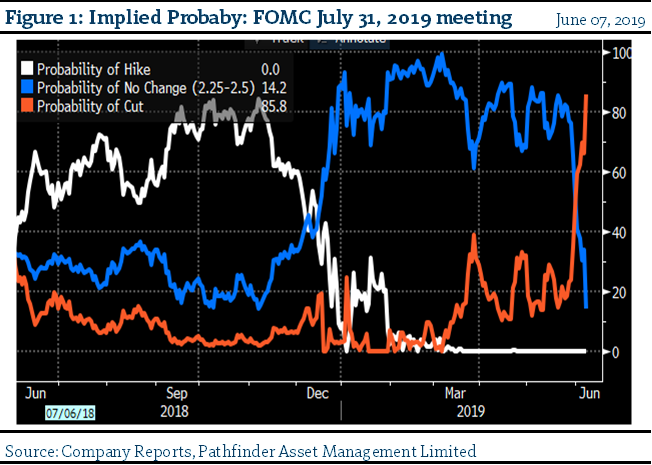Recap & Outlook: Foreign Exchange and Interest Rates
As we noted in the last Outlook, recent volatility in financial markets has been related to ongoing trade tensions between the United States and China. We can now add Mexico to this list after the US administration initiated unorthodox punitive trade tariffs as an attempt to tighten border control. We continue to view this as a temporary issue based more on negotiating tactics than actual long-term negative change in the relationship between these nations. Indeed, the recent short-term negative sentiment has somewhat abated for the time being.
In our last Outlook, we noted that we wanted to spend more time researching and writing about the current debt situation in various markets, as we viewed this was a potential risk that could end the current economic cycle. However, over the past week, we noticed a change in the narrative related to the US economy and employment related to employment and interest rate expectations.
- Growth of US Employees on Nonfarm Payrolls released by the Bureau of Labor Statistics today was much lower than expected. Last month, 263,000 jobs were created. This month, the market expected 175,000 more but only 75,000 were created. We also noticed that US Purchasing Managers Index fell from 55.5 in February to 50.9 this past month. This is just above the critical 50 mark which separates expansion from contraction.
- Canada, on the other hand, had strong employment numbers producing 27,700 jobs, while the market expected only 5,000 jobs would be created. Some were even calling for a substantial drop. This has caused strengthening in the Canadian dollar as interest rate expectations have shifted somewhat in the two countries.

“This means that” with the trade tariffs and various negotiating tactics, the market’s view of the US economy has deteriorated somewhat. In the US, market expectations have shifted towards the FOMC cutting administered rates for the July 31st, 2019 meeting. The last time this happened (fall of 2018) the Fed did not react as the market expected and a rout ensued. At this point, no one knows how the Fed and market will react into the summer, but it is probably safe to say that either way we can expect some volatility. As always, we will continue to watch the data closely and remain focused on the fundamental positioning of the businesses that we own.
National Instrument 31-103 requires registered firms to disclose information that a reasonable investor would expect to know, including any material conflicts with the firm or its representatives. Doug Johnson and/or Pathfinder Asset Management Limited are an insider of companies periodically mentioned in this report. Please visit www.paml.ca for full disclosures.
*All returns are time weighted and net of investment management fees. Returns from the Pathfinder Partners’ Fund and Real Fund are presented based on the masters series of each fund. North American Equity Portfolio and North American High Income Portfolio are live accounts. These are actual accounts owned by the Pathfinder Chairman (Equity) and client (High Income) which contain no legacy positions, cash flows or other Pathfinder investment mandates or products. Monthly inception dates for each fund and portfolio are as follows: North American: Equity Portfolio (January 2011), North American: High Income Portfolio (October 2012) Pathfinder Partners’ Fund (April 2011), Pathfinder Real Fund (April, 2013), Pathfinder International Fund (November 2014) and Pathfinder Resource Fund (May 2018).
Pathfinder Asset Management Limited (PAML) and its affiliates may collectively beneficially own in excess of 10% of one or more classes of the issued and outstanding equity securities mentioned in this newsletter. This publication is intended only to convey information. It is not to be construed as an investment guide or as an offer or solicitation of an offer to buy or sell any of the securities mentioned in it. The author has taken all usual and reasonable precautions to determine that the information contained in this publication has been obtained from sources believed to be reliable and that the procedures used to summarize and analyze such information are based on approved practices and principles in the investment industry. However, the market forces underlying investment value are subject to sudden and dramatic changes and data availability varies from one moment to the next. Consequently, neither the author nor PAML can make any warranty as to the accuracy or completeness of information, analysis or views contained in this publication or their usefulness or suitability in any particular circumstance. You should not undertake any investment or portfolio assessment or other transaction on the basis of this publication, but should first consult your portfolio manager, who can assess all relevant particulars of any proposed investment or transaction. PAML and the author accept no liability of any kind whatsoever or any damages or losses incurred by you as a result of reliance upon or use of this publication.